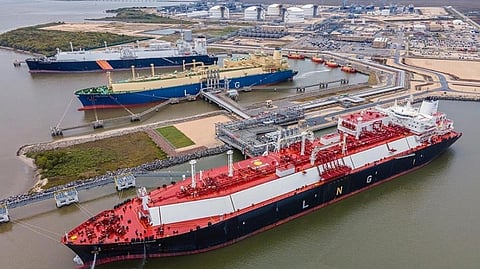

US natural gas futures slid about two per cent on Friday on record output so far this month, ample amounts of fuel in storage, and forecasts for weather to remain warmer than normal through late November that should keep demand lower than usual for this time of year.
Front-month gas futures for December delivery on the New York Mercantile Exchange fell 7.7 cents, or 1.8 per cent, to $4.280 per million British thermal units (mmBtu).
On Thursday, the contract closed at its highest level since March 11. The price increase kept the front-month in technically overbought territory for a seventh straight day for the first time since May 2024.
For the week, the contract was up about four per cent, putting it up for a third week in a row. During those three weeks, the contract has gained about 43 per cent, mostly on expectations that near-record gas flows to liquefied natural gas export plants will boost demand.
In the cash market, meanwhile, average prices at the Waha Hub in the Permian shale basin in West Texas remained in negative territory for a fourth day in a row as pipeline constraints trapped gas in the nation's biggest oil-producing basin.
It was the 26th time Waha prices have dropped below zero this year and compares with an average of $1.32 per mmBtu so far in 2025, 77 cents in 2024, and $2.91 over the previous five years (2019-2023).
Waha first averaged below zero in 2019. It did so 17 times in 2019, six times in 2020, once in 2023, and a record 49 times in 2024.
LSEG said average gas output in the Lower 48 states rose to 108.7 billion cubic feet per day (bcfd) so far in November, up from 107.0 bcfd in October and a record monthly high of 108.0 bcfd in August.
Record output so far this year has allowed energy companies to inject more gas into storage than usual. There was about four per cent more gas in storage than normal for this time of year.
Meteorologists forecast temperatures across the country will remain mostly warmer than normal through November 22, which should limit heating demand.
LSEG projected average gas demand in the Lower 48 states, including exports, would jump from 108.4 bcfd this week to 118.0 bcfd with the coming of some cold weather next week, before dropping to 113.6 bcfd with the return of some seasonal warmth.
The average amount of gas flowing to the eight big US LNG export plants has risen to 17.4 bcfd so far in November, up from a record 16.6 bcfd in October, and those flows are on track to increase further in coming months.
The LNG tanker Imsaikah remained in the Indian Ocean as it slowly headed toward the Atlantic Ocean and Exxon Mobil /QatarEnergy's 2.4-bcfd Golden Pass LNG export plant under construction in Texas, according to LSEG data and analysts' comments.
The ship, expected to arrive at Golden Pass around December 1, is carrying LNG from Qatar that traders and analysts say will be used to cool equipment at the plant as part of its commissioning. The facility is expected to start producing LNG later this year or early next year.
(Reporting by Scott DiSavino in New York; Editing by Joe Bavier)
